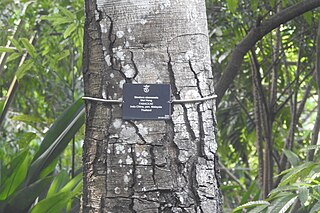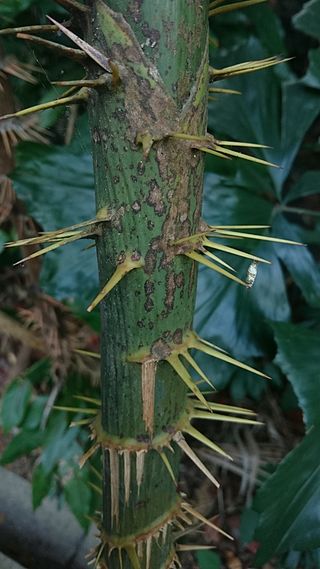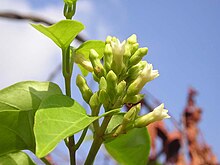
Mimosa pigra, commonly known as the giant sensitive tree, is a species of plant of the genus Mimosa, in the family Fabaceae.

Areca triandra, the wild areca palm, is a palm which is often used as ornamental plant. It is native to India, Bangladesh, Cambodia, Laos, Burma, Thailand, Vietnam, Malaysia, Indonesia, and the Philippines. It is also reportedly naturalized in Panama and in southern China. As a wild plant, it commonly occurs in littoral forest in Southeast Asia.

Sindora siamensis is a species of tree in the subfamily Detarioideae of the family Fabaceae. It has an accepted infraspecific, the variety S. siamensis var. maritima (Pierre) K.Larsen & S.S.Larsen. See taxon box to the right below, and below for details on the variety maritima. The nominate species is found in many countries in tropical Asia. Like several other species in the genus Sindora, its wood is considered valuable; the least concern conservation status may reflect efforts to replant this species, but mortality rates are high. As well as the wood, the plant provides raw material for chemical products, food and drink, and domestic utensils.
Aglaia leptantha is a species of tree in the family Meliaceae. It is found in Mainland and Island Southeast Asia. People use the plant for food, incense, and for human and bovine medicine. Gibbons also eat parts of the tree.

Campylospermum serratum is a plant in the family Ochnaceae. The specific epithet serratum is from the Latin meaning "with teeth", referring to the leaf margin. It is found in Tropical Asia, from Sulawesi, Indonesia to Hainan, Zhōngguó/China and over to southwester India. Gomphia serrata was a previous common name for the species. The plant is used for it wood and its sap is used in folk medicine and in the past for teeth-blackening.

Hydnocarpus annamensis is a tree in the Achariaceae family. It is found in Thailand, Cambodia, Vietnam, southern Yunnan and southern Guangxi in Zhōngguó/China. It is threatened by habitat loss. The plant produces low-quality wood and its fruits are used in traditional medicine.

Myrialepis is a monotypic genus of flowering plant in the palm family. The single species, Myrialepis paradoxa, is native to Southeast Asia. The genus name is a combination of the Greek words meaning "innumerable" and "scale", a description of the fruit, and the epithet is Latin for "paradox".

Elaeocarpus lanceifolius is a tree species in the family Elaeocarpaceae. It is found across tropical Asia from Thailand to Yunnan to Nepal to Karnataka, India. It is used for its wood, fruit, and nuts.
Albizia vialeana is a tree species in the Acacia clade of the family Fabaceae, found in parts of Indo-China. Its wood is used for fuel.
Plectocomia pierreana is a species of liana in the Arecaceae, or palm tree, family. It is a spiny climber, with either a single stem or a cluster of stems up to 35 m in length, stems are 1 to 9 cm in diameter. Its spines are up to 2 cm long.
Brownlowia emarginata is a slightly climbing tree, a member of the family Malvaceae. It occurs in Vietnam, Cambodia, Laos and Thailand.
Homalium dasyanthum is a tree or shrub in the family Salicaceae. It is found in Peninsular Malaysia, Thailand, Vietnam, Cambodia and Myanmar.
Dendrolobium baccatum is a species of flowering plants in the Fabaceae family. A shrub, it occurs in Mainland Southeast Asia. People use it for food and fuel.
Elaeocarpus thorelii is a tree in the family Elaeocarpaceae, endemic to Cambodia, and used for its wood.
Erythroxylum cambodianum is a shrub in the family Erythroxylaceae. It grows in Vietnam, Laos, Cambodia and Thailand. The wood is used for pickets and as firewood.
Gluta cambodiana is a shrub/small tree in the family Anacardiaceae. It occurs in parts of Mainland Southeast Asia. Its wood is used for pickets and fuel.
Combretum trifoliatum is a vine of the family Combretaceae. It is found from Myanmar across Southeast Asia and Wallacea to New Guinea and Australia. It grows in wet places, including where it can be submerged for four months a year by floodwaters. It is unusual in retaining its photosynthesizing leaves when flooded. Parts of the plant are used in traditional medicine.
Helicia nilagirica is a tree of the Proteaceae family. It grows from Thailand across Mainland Southeast Asia to Yunnan, Zhōngguó/China and over to Nepal. It is a source of wood, a pioneer reafforestation taxa, and an ethnomedicinal plant.
Haplophragma sulfureum is a tree in the Bignoniaceae family, found in four countries of Southeast Asia. The pods are used as tinder, while the wood is used for light construction and traditional medicine.
Stixis obtusifolia is a shrub or liana in the Resedaceae family. It is found in parts of Southeast Asia. The wood is used as fuel, the leaves as a tea.







